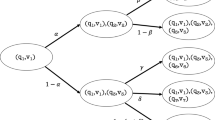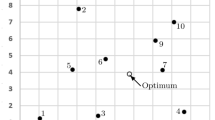Abstract
This paper explores the stochastic dynamics of a simple foodweb system using a network model that mimics interacting species in a biosystem. It is shown that the system can be described by a set of ordinary differential equations with real-valued uncertain parameters, which satisfy a set of linear inequality constraints. The constraints restrict the solution space to a bounded convex polytope. We present results from numerical experiments to show how the stochasticity and uncertainty characterizing the system can be captured by sampling the interior of the polytope with a prescribed probability rule, using the Hit-and-Run algorithm. The examples illustrate a parsimonious approach to modeling complex biosystems under vague knowledge.









Similar content being viewed by others
References
Bélisle C, Boneh A, Caron RJ (1998) Convergence properties of hit-and-run samplers. Stoch Models 14(4):767-800
Bélisle CJP, Romeijn HE, Smith RL (1993) Hit-and-run algorithms for generating multivariate distributions. Math Oper Res 18(2):255-266
Bertsimas D, Thiele A (2006) Robust and data-driven optimization: modern decision-making under uncertainty. INFORMS tutorials in operations research: models, methods, and applications for innovative decision making
Boneh A, Golan A (1979) Constraints’ redundancy and feasible region boundedness by random feasible point generator (rfpg). In: Third European congress on operations research (EURO III), Amsterdam
Boyd S, Vandenberghe L (2004) Convex optimization. Cambridge University Press, Cambridge
Büeler B, Enge A, Fukuda K (2000) Exact volume computation for polytopes: a practical study. In: Polytopes-combinatorics and computation. Springer, New York, pp 131-154
Chen MH, Schmeiser BW (1996) General hit-and-run monte carlo sampling for evaluating multidimensional integrals. Oper Res Lett 19(4):161-169
Delbos F, Gilbert JC et al (2003) Global linear convergence of an augmented lagrangian algorithm for solving convex quadratic optimization problems
Dyer M, Frieze A, Kannan R (1991) A random polynomial-time algorithm for approximating the volume of convex bodies. J ACM (JACM) 38(1):1-17
Dyer ME, Frieze AM (1988) On the complexity of computing the volume of a polyhedron. SIAM J Comput 17(5):967-974
Gelman A, Shirley K (2011) Inference from simulations and monitoring convergence. Handbook of Markov chain Monte Carlo, pp 163-174
Hug D, Reitzner M (2005) Gaussian polytopes: variances and limit theorems. Adv Appl Prob 297-320
Isukapalli SS, Roy A, Georgopoulos PG (1998) Stochastic response surface methods (srsms) for uncertainty propagation: application to environmental and biological systems. Risk Anal 18(3):351-363
Jones GL, Hobert JP (2004) Sufficient burn-in for Gibbs samplers for a hierarchical random effects model. Ann Stat 784-817
Judge GG, Takayama T (1966) Inequality restrictions in regression analysis. J Am Stat Assoc 61(313):166-181
Kaufman DE, Smith RL (1998) Direction choice for accelerated convergence in hit-and-run sampling. Oper Res 46:84-95
Koop G, Potter SM (2011) Time varying VARs with inequality restrictions. J Econ Dyn Control 35(7):1126-1138
Kroese DP, Taimre T, Botev ZI (2011) Handbook of Monte Carlo methods, vol 706. Wiley, New York
Kvasnica M (2009) Real-time model predictive control via multi-parametric programming: theory and tools. VDM Verlag, Saarbruecken
Lasserre JB, Zeron ES (2001) A Laplace transform algorithm for the volume of a convex polytope. J ACM (JACM) 48(6):1126-1140
Lazar R, Meeden G (2003) Exploring imprecise probability assessments based on linear constraints. ISIPTA 3:361-371
Liu S, Zhang J, Zhu B (2007) Volume computation using a direct Monte Carlo method. Comput Combin 198-209
Lovász L (1999) Hit-and-run mixes fast. Math Program 86(3):443-461
Lovász L, Vempala S (2006) Simulated annealing in convex bodies and an O*$(n^{4})$ volume algorithm. J Computer Syst Sci 72(2):392-417
Mullon C, Fréon P, Cury P, Shannon L, Roy C (2009) A minimal model of the variability of marine ecosystems. Fish Fish 10:115-131
Nocedal J, Wright SJ (1999) Numerical optimization. Springer, New York
Planque B, Lindstrøm U, Subbey S (2014) Non-deterministic modelling of food-web dynamics. PloS one 9(10):e108,243
Polovina JJ (1984) An overview of the Ecopath model. FishByte 2:5-7
Roese-Koerner L, Devaraju B, Sneeuw N, Schuh WD (2012) A stochastic framework for inequality constrained estimation. J Geodesy 86(11):1005-1018
Shao QM, Ibrahim JG (2000) Monte Carlo methods in Bayesian computation. Springer Series in Statistics, New York
Silverman BW (1986) Density estimation for statistics and data analysis, vol 26. CRC press, Boca Raton
Sivia DS (1996) Data analysis: a Bayesian tutorial. Oxford University Press, Oxford
Smith RL (1980) Monte Carlo procedures for generating random feasible solutions to mathematical programs. In: A Bulletin of the ORSA/TIMS Joint National Meeting, Washington, DC, vol 101
Smith RL (1984) Efficient Monte Carlo procedures for generating points uniformly distributed over bounded regions. Oper Res 32(6):1296-1308
Smith RL (1996) The hit-and-run sampler: a globally reaching Markov chain sampler for generating arbitrary multivariate distributions. In: Proceedings of the 1996 winter simulation conference, pp 260-264
Turlach BA (1993) Bandwidth selection in kernel density estimation: a review. Université catholique de Louvain
Verhoef HA, Olff H (2010) Trophic dynamics of communities. Commun Ecol Process Models Appl 25-36
Wolak FA (1989) Testing inequality constraints in linear econometric models. J Econ 41(2):205-235
Zhu J, Santerre R, Chang XW (2005) A Bayesian method for linear, inequality-constrained adjustment and its application to GPS positioning. J Geodesy 78(9):528-534
Acknowledgments
This work has been partly funded by the IMR Research Program on Marine Processes and Human Influence, ADMAR (RCN Project No. 200497/I30), and KOFA (IMR project 14452-02).
Author information
Authors and Affiliations
Corresponding author
Appendix: Basic definitions
Appendix: Basic definitions
The following definitions are mostly adapted from Kvasnica (2009).
Definition 1
(Convexity) A set of points S in the n-dimensional space is convex, if the line segment connecting any two points \(x_{1},x_{2} \in S\), belongs completely in S. That is
Definition 2
(Polyhedron) A convex set \(\mathcal {Q}\subseteq \mathcal {R}^{n}\) given as an intersection of a finite number of closed half-spaces \(\mathcal {Q} = \{x\in \mathcal {R}^{n}|Q^{x}x \le Q^{c}\}\), is called a polyhedron.
Definition 3
(Polytope) A bounded polyhedron \(\mathcal {P}\subset \mathcal {R}^{n}\) is called a polytope if
By definition, every polytope represents a convex, bounded and closed set.
Definition 4
(Convex Hull) The convex hull of a set of points is the smallest convex region containing all points in the set.
Rights and permissions
About this article
Cite this article
Subbey, S., Planque, B. & Lindstrøm, U. Exploring stochasticity and imprecise knowledge based on linear inequality constraints. J. Math. Biol. 73, 575–595 (2016). https://doi.org/10.1007/s00285-015-0959-z
Received:
Revised:
Published:
Issue Date:
DOI: https://doi.org/10.1007/s00285-015-0959-z




